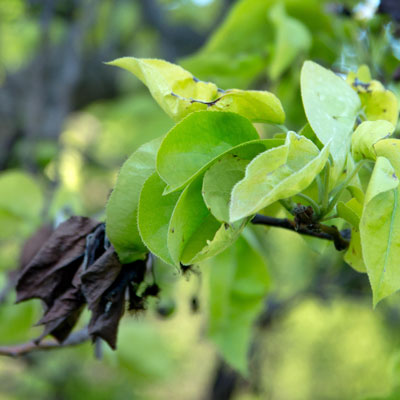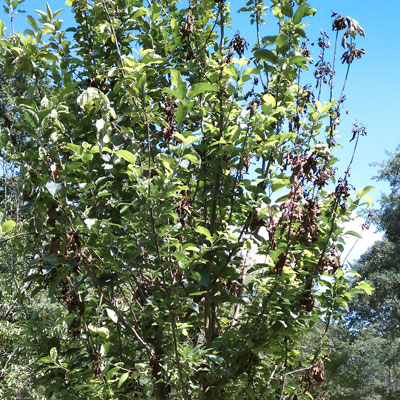Fire Blight and How to Avoid It
Pears are the one type of plant that is most commonly associated with the bacterial disease known as “fire blight.” Apples, however, are also frequently hit. Here are some facts you’ll want to know as you try to deal with it.
• Fire blight attacks only members of the Rose Family of plants. Other plant families are not susceptible. If plants from other families show similar symptoms, it’s due to wind, cold, drought or some other reason, but not to the bacterial disease.

Some pears are highly susceptible to fire blight. Asian pears (photo) and those especially soft-fleshed types such as Bartlett are particularly susceptible.
• Members of the Rose Family that are susceptible include pears, apples, loquats, cotoneasters and (rarely) photinias.
• Members of the Rose Family that are almost never affected include peaches, plums, apricots, blackberries, strawberries and roses. It should be noted that ornamental pears such as Bradford are usually not bothered, although in 2012 the disease ran rampant on them across much of East Texas.
• The disease causes lesions on twigs and small branches that look as if someone had burned the wood with a blow torch. All of the leaf and stem tissue from that point out to the ends of the branches turns brown or black and remains attached to the tree.
• The disease is spread by bees during the flowering season. Agricultural streptomycin or copper-based fungicides are the recommended preventive sprays. They must be made during full bloom, preferably late in the evening. This will not impact the bee population.
• If you encounter fire blight during the growing season, trim off the affected tissue. Prune several inches beyond the affected lesion. Disinfect your pruning tool between each cut by dipping it into a bucket of 90 percent water and 10 percent chlorine bleach. When you are finished with your work, wash and oil the pruning tool to prevent corrosion.
• Above all, avoid species and varieties that are known to have serious problems with fire blight. Prime among those would be Bartlett pear. The variety Orient is a much better choice for Texas.

